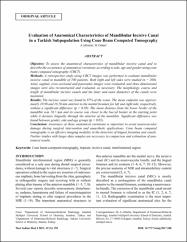| dc.contributor.author | Akbulut, Aslıhan | |
| dc.contributor.author | Orhan, Kaan | |
| dc.date.accessioned | 2021-12-03T08:27:30Z | |
| dc.date.available | 2021-12-03T08:27:30Z | |
| dc.date.issued | 2021 | en_US |
| dc.identifier.citation | Akbulut, A. ve Orhan, K. (2021). Evaluation of anatomical characteristics of mandibular incisive canal in a Turkish subpopulation using cone beam computed tomography. West Indian Medical Journal, 69(5), 292-303. https://dx.doi.org/10.7727/wimj.2017.180 | en_US |
| dc.identifier.issn | 0043-3144 | |
| dc.identifier.issn | 2309-5830 | |
| dc.identifier.uri | https://dx.doi.org/10.7727/wimj.2017.180 | |
| dc.identifier.uri | https://hdl.handle.net/20.500.12511/8608 | |
| dc.description.abstract | Objective: To assess the anatomical characteristics of mandibular incisive canal and to describe the occurrence of anatomical variations according to side, age and gender using cone beam computed tomography (CBCT).
Methods: A retrospective study using CBCT images was performed to evaluate mandibular incisive canal in mandible of 100 patients. Both right and left sides were studied (n = 200). Axial, sagittal, cross-sectional and panoramic images were evaluated, and three dimensional images were also reconstructed and evaluated, as necessary. The morphology, course and length of mandibular incisive canals and the inner and outer diameters of the canals were measured.
Results: The incisive canal was found in 87% of the scans. The mean endpoint was approximately 10.98 and 10.26 mm anterior to the mental foramen for left and right side, respectively, without a significant difference (p > 0.05). The mean distance from the lower border of the mandible was 10.7 mm and its course was closer to the buccal border at the starting point while it deviates lingually through the anterior of the mandible. Significant difference was found between gender; side and age groups (p < 0.05).
Conclusion: Awareness of these anatomical variations is important to avoid neurovascular damage during surgical intervention and anaesthetic applications. Cone beam computed tomography is an effective imaging modality in the detection of lingual foramina and canals. Further studies with larger data samples are necessary in comparison and estimation of anatomical results. | en_US |
| dc.language.iso | eng | en_US |
| dc.publisher | University of West Indies Faculty of Medical Science | en_US |
| dc.rights | info:eu-repo/semantics/openAccess | en_US |
| dc.rights | Attribution 4.0 International | * |
| dc.rights.uri | https://creativecommons.org/licenses/by/4.0/deed.en_US | * |
| dc.subject | Cone Beam Computed Tomography | en_US |
| dc.subject | Implant | en_US |
| dc.subject | Incisive Canal | en_US |
| dc.subject | Interforaminal Region | en_US |
| dc.title | Evaluation of anatomical characteristics of mandibular incisive canal in a Turkish subpopulation using cone beam computed tomography | en_US |
| dc.type | article | en_US |
| dc.relation.ispartof | West Indian Medical Journal | en_US |
| dc.department | İstanbul Medipol Üniversitesi, Diş Hekimliği Fakültesi, Ağız, Diş ve Çene Radyolojisi Ana Bilim Dalı | en_US |
| dc.authorid | 0000-0001-7931-4464 | en_US |
| dc.identifier.volume | 69 | en_US |
| dc.identifier.issue | 5 | en_US |
| dc.identifier.startpage | 292 | en_US |
| dc.identifier.endpage | 303 | en_US |
| dc.relation.publicationcategory | Makale - Uluslararası Hakemli Dergi - Kurum Öğretim Elemanı | en_US |
| dc.identifier.doi | 10.7727/wimj.2017.180 | en_US |
| dc.identifier.wosquality | Q4 | en_US |
| dc.identifier.scopusquality | Q4 | en_US |



















